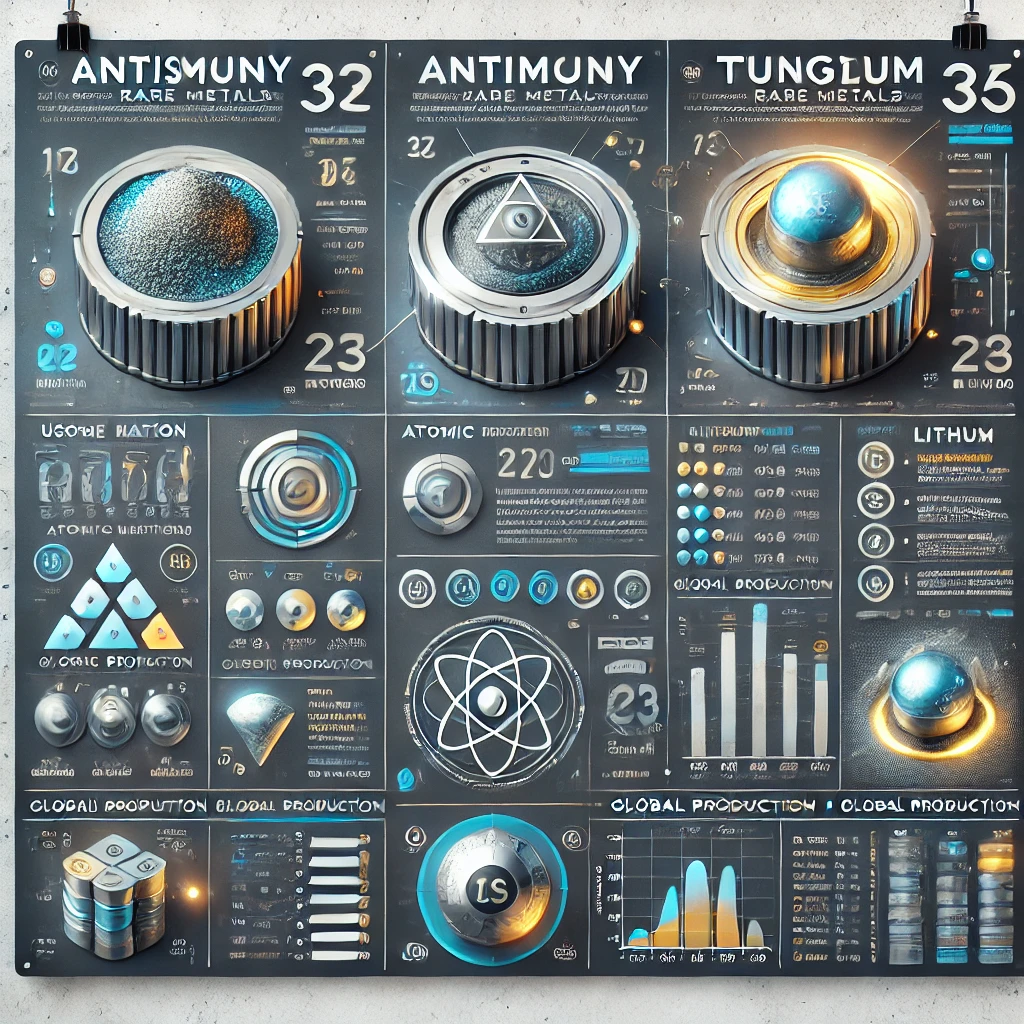Antimony vs. Other Rare Metals: A Comparative Guide
Antimony, a critical metalloid, plays a significant role in various industries alongside other rare metals like lithium, cobalt, and tungsten. While each of these metals has unique properties and applications, understanding how antimony compares to other rare metals can help industries make informed decisions about their use in manufacturing, technology, and sustainable solutions. This guide explores the properties, applications, availability, and environmental impact of antimony compared to other rare metals.
Understanding Antimony
Key Characteristics
- Symbol: Sb
- Atomic Number: 51
- Properties: Lustrous, brittle, and corrosion-resistant metalloid with excellent flame retardant properties.
Major Applications
- Flame Retardants: Enhances fire resistance in plastics, textiles, and coatings.
- Electronics: Used in semiconductors and printed circuit boards.
- Energy Storage: A component in lead-acid and molten-salt batteries.
- Alloys: Improves durability and corrosion resistance in lead and tin alloys.
Comparative Analysis: Antimony vs. Other Rare Metals
1. Antimony vs. Lithium
Properties:
- Lithium is a lightweight, highly reactive metal, essential for energy storage.
- Antimony is heavier, less reactive, and primarily used for its flame retardant and metallurgical properties.
Applications:
- Lithium: Batteries for electric vehicles, renewable energy storage, and portable electronics.
- Antimony: Flame retardants, alloys, and traditional lead-acid batteries.
Availability:
- Lithium reserves are concentrated in South America (Chile, Bolivia) and Australia.
- Antimony is mainly sourced from China, Russia, and Bolivia.
Environmental Impact:
- Lithium mining often results in water depletion and habitat destruction.
- Antimony mining poses risks of water contamination and soil degradation.
2. Antimony vs. Cobalt
Properties:
- Cobalt is a ductile metal with high melting points and excellent magnetic properties.
- Antimony is brittle with high thermal stability.
Applications:
- Cobalt: Rechargeable batteries, alloys, and catalysts.
- Antimony: Flame retardants, electronics, and industrial alloys.
Availability:
- Cobalt is predominantly mined in the Democratic Republic of Congo (DRC), leading to ethical sourcing concerns.
- Antimony production is dominated by China, with a relatively stable supply chain.
Environmental Impact:
- Cobalt mining faces significant scrutiny for its ecological and ethical challenges.
- Antimony mining has fewer ethical concerns but still poses environmental risks.
3. Antimony vs. Tungsten
Properties:
- Tungsten is an exceptionally hard and dense metal with the highest melting point of all elements.
- Antimony is softer, less dense, and used primarily for its chemical properties.
Applications:
- Tungsten: Cutting tools, aerospace components, and military applications.
- Antimony: Fireproofing materials, semiconductors, and batteries.
Availability:
- Tungsten reserves are found in China, Vietnam, and Russia.
- Antimony is sourced from similar regions but is more widely available.
Environmental Impact:
- Tungsten mining has a lower ecological footprint compared to other rare metals.
- Antimony mining has higher risks of contamination and waste management issues.
Key Differences: Applications and Market Trends
| Aspect | Antimony | Lithium | Cobalt | Tungsten |
|---|---|---|---|---|
| Primary Use | Flame retardants, alloys, batteries | Energy storage, electric vehicles | Rechargeable batteries, catalysts | Cutting tools, aerospace, military |
| Global Demand | Moderate | High | Very High | Stable |
| Environmental | Water contamination, soil erosion | Water depletion, habitat destruction | Ethical and ecological challenges | Minimal |
| Supply Chain | Concentrated but stable | Rapidly expanding | Unstable due to ethical concerns | Stable |
Antimony’s Unique Advantages
- Cost-Effective: Antimony is more affordable compared to lithium and cobalt, making it suitable for budget-sensitive industries.
- Versatility: It finds applications across multiple sectors, from fireproofing to energy storage.
- Sustainability Potential: Increasing recycling initiatives can reduce reliance on mining.
Challenges Facing Antimony
- Environmental Risks: Mining and processing can lead to contamination and waste issues.
- Supply Chain Dependence: Heavily reliant on a few countries, especially China.
- Competition: Emerging alternatives in flame retardants and batteries may reduce demand.
Future Trends for Antimony and Rare Metals
Recycling and Circular Economy:
- Efforts to recover antimony from e-waste and industrial byproducts.
Innovative Applications:
- Research into antimony’s potential in next-generation batteries and nanotechnology.
Sustainability Focus:
- Development of eco-friendly mining practices and green alternatives for flame retardants.
Market Diversification:
- Expanding sources of antimony to reduce reliance on dominant producers like China.
Conclusion
Antimony holds a unique position among rare metals, offering affordability, versatility, and wide-ranging applications. While it may not match the high demand of lithium or cobalt, its role in flame retardants, electronics, and energy storage remains indispensable.
As industries and governments prioritize sustainability, antimony’s potential for recycling and innovation could secure its place in the evolving market of rare metals. Comparing its environmental footprint and supply chain stability to other metals highlights both its advantages and areas for improvement, ensuring its continued relevance in the modern industrial landscape.
